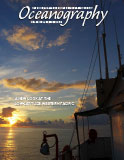Article Abstract
We examine velocity structure and variability across the Kuroshio east of Luzon and Taiwan using two years of Seaglider observations. The Kuroshio exhibits a single velocity maximum south of Luzon Strait, strengthened downstream. It is occasionally accompanied by a second velocity maximum, and the two together form a dual-core structure east of Taiwan. Two possible mechanisms are responsible for the dual-core phenomenon. One is attributed to intrusion of the Kuroshio into the South China Sea through Luzon Strait, which occurs normally during persistent northeasterlies in winter. The streamline diffluence across the strait during the Kuroshio’s westward intrusions and subsequent shaping of the boundary current through interaction with a quasi-permanent anticyclonic recirculation east of Taiwan favors the appearance of the offshore velocity maximum. The other possible mechanism is related to the dissipation of westward-propagating mesoscale anticyclonic eddies. As the impinging eddy deforms and is eventually dissipated along the Kuroshio’s eastern flank, the northward flow contiguous to the western half of this eddy is enhanced, causing an offshore core downstream. Glider-observed θ–S properties in the dual cores indicate different water masses are mixing, consistent with two different mechanisms causing the dual cores.

